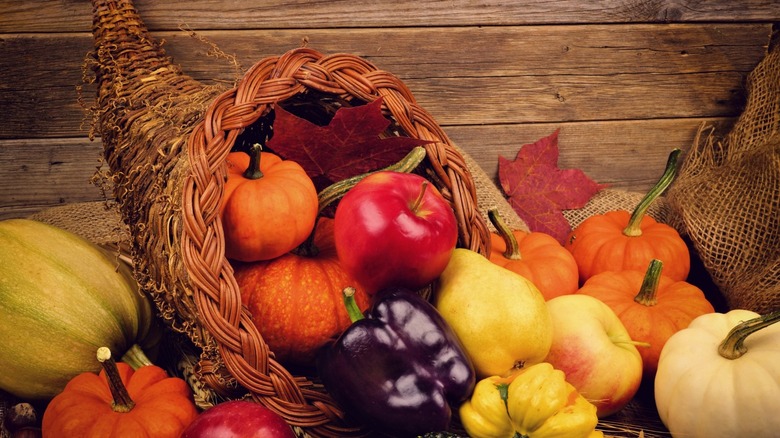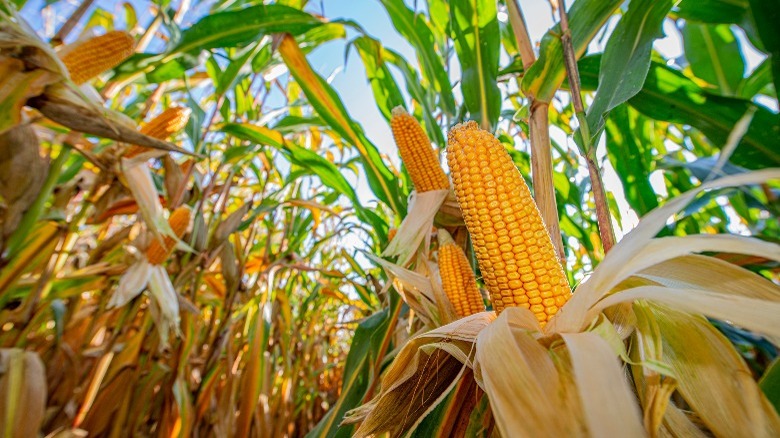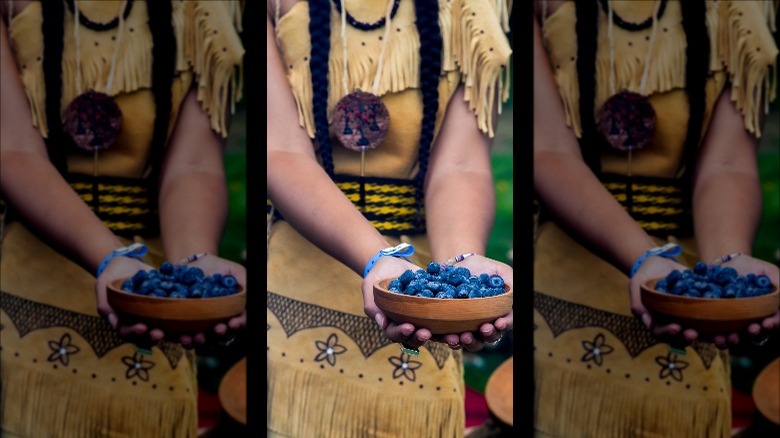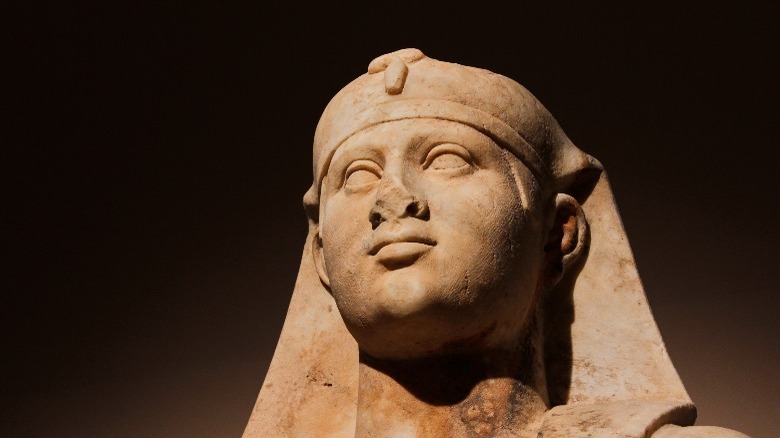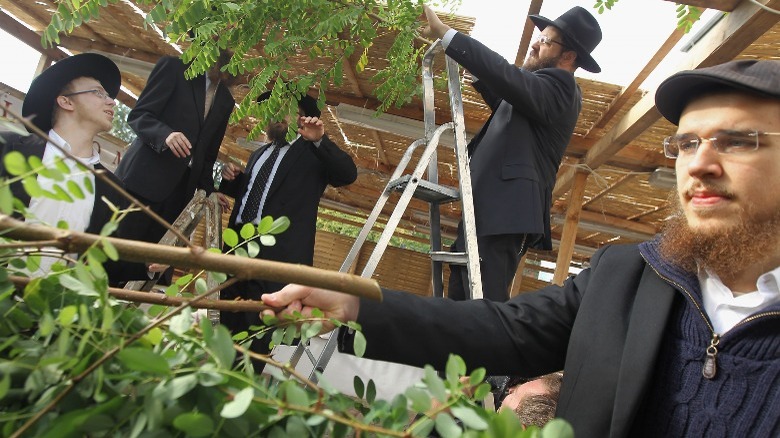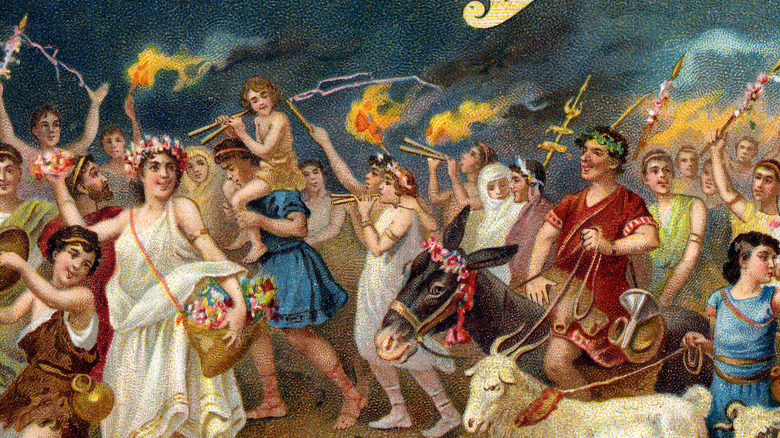The Ancient Origins Of Thanksgiving
The story of the first Thanksgiving is a controversial one, glossing over the darker aspects of colonists' interactions with Native Americans. As History points out, the Plymouth Colony's alliance with the Wampanoag tribe was unusually peaceful. However, the original celebration did happen. Pilgrim chronicler Edward Winslow described it as a three-day feast after the harvest, and the Wampanoag king Massasoit and 90 of his men attended lots of "recreations." Both groups provided food.
This type of celebration probably wouldn't have been unusual for the Pilgrims or the Native Americans, as both cultures had a tradition of harvest festivals. In fact, harvest festivals have long been common worldwide. New World Encyclopedia lists harvest festivals in many parts of East Asia (China, Vietnam, Japan, and Korea) and Central Europe (Germany, Austria, and Switzerland), but these probably wouldn't have influenced that first Massachusetts gathering. Let's take a look at the cultural influences that might have led to the first American Thanksgiving.
Celtic cultures commemorated the harvest with a festival dedicated to Lugh, the god of light, son of the sun. He transferred his power each year into the grain grown by the Celts and thus was sacrificed when the grain was harvested but later reborn (via Ancient Origins). Per Britannica, myths about and tributes to Lugh existed in modern-day France and the Netherlands as well as Ireland and Wales. Unlike American Thanksgiving, this festival happened at the beginning of the harvest. A separate one occurred at the end, according to Ancient Origins.
Celtic and English traditions
Celtic cultures commemorated the harvest with a festival dedicated to Lugh, the god of light, son of the sun. He transferred his power each year into the grain grown by the Celts and thus was sacrificed when the grain was harvested but later reborn (via Ancient Origins). Per Britannica, myths about and tributes to Lugh existed in modern-day France and the Netherlands, as well as Ireland and Wales. Unlike American Thanksgiving, this festival happened at the beginning of the harvest. A separate one occurred at the end, according to Ancient Origins.
Despite their proximity to Celtic lands, the Pilgrims would have, of course, been most influenced by English traditions. According to Countryfile Magazine, English harvest festivals predated Christianity. Some can be attributed to Saxon farmers, who believed the spirit of the corn resided in the last sheath harvested each year. They would make dolls out of this last sheath and keep them until the next year to assure another good harvest. This tradition persists in some parts of England, and corn sheaths are sometimes made into other shapes, too (via The Countryside Charity).
Medieval celebrations of Michaelmas caused harvest festivals to become more common in England. Celebrated on September 29, it represented the end of the harvest and was commemorated with a big feast (per Countryfile Magazine). In more modern times, harvest festivals in England have occurred on the Sunday closest to the harvest moon — the full moon around the time of the autumnal equinox. The meals included different meats and vegetables along with desserts and ale. While originally hosted at a farmer's home, they've shifted to being celebrated at churches, apparently to contain the "unrestrained riot and excess" that occurred at the festivals (via Countryfile Magazine).
Native American traditions
Native Americans were commemorating the harvest long before the arrival of Europeans. According to a member of the Lumbee and Creek tribes, Eastern Woodland cultures in particular celebrated the harvest because they were more agricultural than tribes in the west (via Pow Wows). These celebrations might occur anytime between August and December. The recognition of the harvest included preparing homes and drying food for the coming winter, but also fun activities like feasts, music, dancing, and gifts. This might last a week or even longer.
Just like the modern American holiday, Native American harvest festivals included giving thanks for crops, specifically to the Great Spirit, per New World Encyclopedia. Though they still occur, the Partnership with Native Americans organization says they're becoming less common because fewer Native Americans farm. In addition to general harvest festivals, Chenae Bullock of the Shinnecock Tribe of Long Island, New York, said her tribe celebrated specific harvests like strawberries (the first berries of the year) and cranberries (the last berries of the year). "On the East Coast, we've always had Thanksgiving," she said (via The Harvard Gazette).
Egyptian traditions
Though the conservative Christian Pilgrims might not have liked it, English harvest festivals were most likely also influenced by the ancient, pagan world. Roman invaders in the early centuries A.D. would have brought their own culture into Great Britain along with that of other territories they'd conquered. This may have included Egypt, which came under Roman rule slightly before Britain did (via World History Encyclopedia).
Like Britain, Ancient Egypt's most significant crops were grain. To Egyptians, grain represented the god Osiris's body, according to Tour Egypt. Thus, the celebration of the harvest became intertwined with the celebration of his death and resurrection, not unlike the Celtic festival of Lugh. The festival of Osiris, called Khoiak, derived from an even older celebration of the agricultural god Sokar. During the festival, people would plant gardens, and their growth symbolized Osiris' rebirth (via World History Encyclopedia).
During the predynastic period (around 6000-3150 B.C.), ancient Egyptians also celebrated the god Min with a harvest festival, per World History Encyclopedia. Min represented virility and reproduction, so the festival was an expression of hope for fertility of the land and the people. During this festival, a statue of Min would be carried to the pharaoh. He would then cut the first of that year's grain to commence the harvest or hoe and water the ground (via Ancient Egypt Online). According to Tour Egypt, this festival also involved a procession with singing and dancing.
Jewish traditions
Modern Israel was also under Roman control around the same time as Egypt and Britain, and Jewish people already had their own harvest festival, which is still celebrated today. Sukkot is, ironically, a commemoration of the Jewish people's escape from enslavement in Egypt, per the American Jewish Committee. The Jewish Museum of London explains that the festival begins on the 15th of the Jewish month of Tishrei and lasts for seven days to fulfill a commandment made by God in the book of Leviticus. This year, it began on October 9 (via My Jewish Learning).
For Sukkot, the American Jewish Committee explains, Jewish people build outdoor huts called sukkah in which they sleep and eat during the festival. This represents the temporary shelters the Jewish people slept in during their 40 years of wandering in the desert after their escape. The sukkah must have two and a half walls and an open roof so a sleeper can see the sky, according to the Jewish Museum of London. The roof is often made of bamboo or greenery, and being outdoors is meant to help a person focus on the beauty of nature.
According to the American Jewish Committee, Sukkot is also "an agricultural feast of thanksgiving" and is celebrated by gathering with guests.
Greek and Roman traditions
The Romans, of course, also had their own harvest traditions. Like many aspects of Roman religion, these were probably borrowed from the Greeks (via National Geographic). The pre-Hellenic Greek god Cronus was associated with agriculture and was celebrated through the harvest festival Kronia. According to Britannica, Cronus was king of the Titans and the father of many major Greek gods: Zeus, Poseidon, Hades, Hera, Demeter, and Hestia.
Britannica says Cronus later corresponded to the Roman god Saturn, and Kronia celebrations were similar to Saturnalia. The University of Pennsylvania's Classics department explains that Cronus was also god of the grain harvest and that while Kronia wasn't a major holiday, it was a day on which enslaved people could eat with their masters. According to Getty, this carried over into Saturnalia. Saturnalia was less a festival of thanksgiving and more of hope for a good harvest the following year. It began on December 17 and lasted for seven days (via Getty). It included a public banquet and a religious ceremony, but Britannica describes the atmosphere as similar to Mardi Gras. Interestingly, Saturnalia may have influenced Christmas more than Thanksgiving: Getty says the Saturnalian traditions of gift-giving, garland-hanging, and candle-lighting were probably assimilated into later generations' Christmas celebrations.
